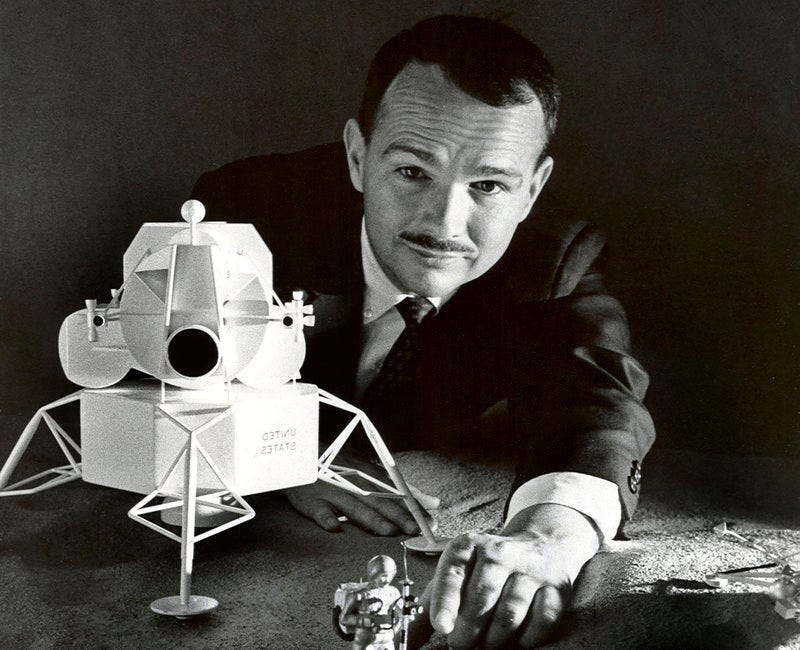The Only Man to Be Buried on the Moon
From the Medium article at:
https://medium.com/history-of-yesterday/the-only-man-to-be-buried-on-the-moon-b624b4a6ba66
https://medium.com/history-of-yesterday/the-only-man-to-be-buried-on-the-moon-b624b4a6ba66
Posted here by Kristen, your favorite elf.
The Only Man to Be Buried on the Moon
Resting on the Moon since 1999

 Humanity has seen only a handful of people that actually had the honor to step on earth’s natural satellite, but at present, there is only one person who is “buried” on an astronomical body orbiting Earth. The name of the soul that now rests on the Moon is Eugene Shoemaker, an astrogeologist who had worked with NASA since the 1960s and became famous when a comet that crashed on Jupiter in 1994 received his name (Shoemaker-Levy Comet).
Humanity has seen only a handful of people that actually had the honor to step on earth’s natural satellite, but at present, there is only one person who is “buried” on an astronomical body orbiting Earth. The name of the soul that now rests on the Moon is Eugene Shoemaker, an astrogeologist who had worked with NASA since the 1960s and became famous when a comet that crashed on Jupiter in 1994 received his name (Shoemaker-Levy Comet).
The reason this comet became so famous is that this was the first time in human history that we had the chance to witness a planetary collision. This event was mainly reported by Eugene Shoemaker and David Levy, hence the two monikers within the comet’s name.
A long-lived passion
As an astrogeologist, he had always been fascinated by space and the idea of humans colonizing the earth’s natural satellite. Eugene was also schooled in the world of geology and this is where he used both of high interests to research the Moon and prepare astronauts for the type of soil/rock they would land on. As much as he loved the idea of traveling to the Moon he always knew that he may not be able to make it as he was the brain and not the muscle of NASA.
He was also very famous in the United States not only due to his intensive studies of craters around the state but also for founding the Program for archeological studies within the US in the 1960s. All of his knowledge was a very valuable element in the success of the Apollo missions and other NASA projects. In fact, the origins of what’s now known as Meteor Crater in Arizona had been uncertain before his Ph.D. dissertation settled the matter. This was the same crater that most astronauts that took part in the Apollo missions were trained in as it was quite similar to the terrain on the Moon.
The better the astronauts understood the terrain they were about to face the better they could get prepared for what was ahead. Getting to the Moon was only half of the mission. As mentioned before, Eugene’s long dream since he first approached astronomy was to go to the Moon to see our beautiful world from a different perspective. However, his focus was on his own work, he knew he was more valuable as an astronomist and geologist than as an astronaut.
Reaching his final destination
Sadly, his life was cut short due to a car accident that took place on the 18th of July 1997. However, this wasn’t going to be Eugene’s final journey. A close work colleague had the idea to actually send his corpse to the Moon as she knew this was his life-long dream. NASA thought that this was a very good idea to show their appreciation for his work over the years. His body was cremated as transporting his ashes would have been much easier than transporting his corpse.
His ashes were loaded on the Lunar Prospector, a rocket which launched on the 6th of January 1998 with the goal of reaching the South pole of the Moon. Eugene Shoemaker’s ashes were inside a special polycarbonate capsule produced by a company called Celestis that was actually specializing in sending dead people to space but never onto the Moon. The outside of the capsule was marked with his name, his date of birth, and date of death as well as a picture of him training astronauts in a geology field trip (the same picture you can see above).
The Luna prospector reached the moon on the 31st of July 1999. On the same day, they launched the capsule containing Shoemaker’s ashes which crashed onto the moon, thus “burying” Eugene Shoemaker in the place he had always wanted to reach.


Comments
Post a Comment